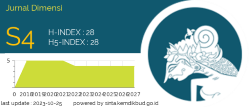STUDI RESIKO KERJA OPERATOR LABORATORIUM PENGUJIAN AIR DENGAN MENGGUNAKAN METODE QEC (QUICK EXPOSURE CHECK) (STUDI KASUS PT. SUCOFINDO BATAM)
Abstract
Laboratorium PT Sucofindo Batam memiliki laboratorium pengujian yang berkaitan dengan mutu dalam hubungannya dengan keselamatan, keandalan dan kinerja produk atau kualitas material. Salah satu pengujian yang dilakukan di laboratorium ini adalah pengujian air. Pekerjaan ini dilakukan dengan cara manual dan berulang ulang dalam posisi berdiri yang dilakukan selama rata-rata 8 jam kerja dengan 1 jam istirahat setelah 4 jam bekerja. Penelitian ini bertujuan untuk menganalisa fasilitas kerja yang ada di laboratorium pengujian air dengan pendekatan Quick Exposure Check (QEC) di PT.Sucofindo Batam. Pengumpulan data dilakukan dengan studi lapangan, wawancara terhadap pekerja, dan kuesioner. Output yang didapat berupa total exposure level dari skor 4 bagian tubuh. Hasil penelitian menunjukkan bahwa terdapat keluhan pada bagian punggung, bahu dan leher dikarenakan proses kerja yang membungkuk. Selain itu hasil QEC menunjukkan ≥ 50% (61,32%) yang artinya perlu tindakan (action) yang harus diambil yaitu perbaikan fasilitas kerja guna mengurangi keluhan dan kelelahan akibat kerja.
Kata Kunci : laboratorium pengujian air, keluhan, kelelahan, QEC
The Laboratory of PT Sucofindo Batam has testing laboratories that related with quality in relation to safety, reliability and product performance or material quality. One of the tests conducted in this laboratory is water testing. This work is done manually and repeatedly in a standing position performed for an average of 8 hours of work with 1 hour of rest after 4 hours of work. The purpose of this research is to analyze existing work facilities in water testing laboratory with Quick Exposure Check (QEC) approach in PT.Sucofindo Batam. Data collection was done by field study, interview to workers, and questionnaire. Output obtained in the form of total exposure level of score of 4 body parts. The results showed that there are complaints on the back, shoulders and neck due to work processes that bend. In addition QEC results show ≥ 50% (61.32%) which means need action that must be taken to improve the work facilities to reduce complaints and fatigue due to work.
Keywords: water testing laboratory, complaints, fatigue, QEC
Full Text:
PDFReferences
Irdiastadi, H., & Yassierli. (2014). Irdiastadi_Yassierli_Ergonomi Suatu Pengantar.pdf. (Nia, Ed.). Bandung: PT Remaja Rosdakarya.
Nurmianto, E. (1996). Nurmianto_Konsep Dasar dan Aplikasinya.pdf. (I. K. Gunarta, Ed.). Jakarta: PT.Candimas Metropole.
Santoso, A., Siboro, B. A. H., & Annisa Purbasari. (2014). Memenuhi Standar Pengukuran. Profisiensi, 2(2), 81–91. Retrieved from http://journal.unrika.ac.id/index.php/jurnalprofisiensi/article/view/317/293
Sholihah, Q. (2013). Sholihah_Ergonomi dan Keselamatan Kerja.pdf. Surabaya: Pusat Penerbitan dan Percetakan Unair (Aup).
Sholihah, Q., & Anward, H. H. (2012). Sholihah_Anward-Ergonomika dan Faktor Manusia.pdf. Yogyakarta: Nusa Media.
Stanton, N., Hedge, A., Brookhuis, K., Salas, E., & Hendrick, H. (2005). Handbook of Human Factors and Ergonomics Methods. Handbook of Human Factors and Ergonomics Methods. London: CRC Press. https://doi.org/10.1201/9780203489925
Tarwaka. (2011). Tarwaka_Ergonomi Industri.pdf. Surakarta: Harapan Press.
DOI: https://doi.org/10.33373/dms.v6i2.1048
Refbacks
- There are currently no refbacks.

This work is licensed under a Creative Commons Attribution-NonCommercial-ShareAlike 4.0 International License.











